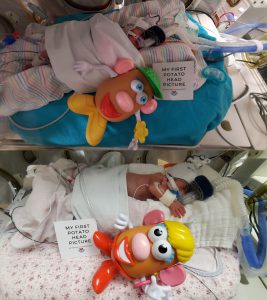Key points
- Patent ductus arteriosus (PDA) is a common congenital heart defect in pre-term infants.
- Children’s Minnesota developed a standard guideline and protocol for pre-term infants that require transcatheter closure of their PDA and a standardized protocol based on clinical and echo criteria to assess which patients may benefit from the procedure.
- The protocol accounts for every team involved in the process: neonatologist, cardiologists, nurses, respiratory therapists, the cardiac catheterization lab, nurse practitioners and cardiac anesthesiologists.
The ductus arteriosus is a normal fetal blood vessel that connects two arteries — the aorta and the pulmonary artery — that carry blood away from the heart. In most babies who have an otherwise normal heart, the ductus will close on its own shortly after birth. If it doesn’t close, the result is a patent (open) ductus arteriosus (PDA). The PDA allows too much blood to flow into the lungs, putting a strain on the heart and increasing blood pressure in the pulmonary arteries.
PDA is very common in preterm infants, occurring in up to 80% of pre-term infants. Historically, these patients had to undergo a surgical procedure, which is stressful on a preterm infant and comes with more risks.
Minimally invasive option for PDA closure in pre-term infants
The Kid Experts® at Children’s Minnesota have developed a standard guideline and protocol for pre-term infants requiring transcatheter closure of their PDA using the Amplatzer™ Piccolo Occluder – a minimally invasive device specifically designed to close PDA in premature infants. The protocol accounts for every team involved in the process: neonatologist, cardiologists, nurses, respiratory therapists, the cardiac catheterization (cath) lab, nurse practitioners and cardiac anesthesiologists. In addition, Children’s Minnesota created a standardized echocardiogram (echo) protocol to assess which infants may benefit from the procedure.
Furthermore, given how fragile pre-term infants are, and the fact that they have to be moved out of the neonatal intensive care unit (NICU) and into the cath lab for the procedure, Children’s Minnesota developed a protocol to ensure everything goes as smoothly as possible. This includes pre-op preparation, transport procedures, temperature regulation in the cath lab, medications to help ensure hemodynamic stability during and after the procedure, and post-op monitoring.
Benefits of transcatheter closure of PDA vs. surgery
- Less invasive, better tolerated procedure with less changes in hemodynamic status, requiring less vasopressor support, less opioids and sedation medications.
- Noninvasive approach allows for significantly less chance of procedural complications. These complications are both short-term such as hemodynamic changes and pneumothoraxes and long-term complications with surgical ligation i.e. vocal cord paralysis (as high as ~30% in some studies), and scoliosis (as high as ~50% in some studies).
- Data suggests patients improve and have better respiratory outcomes, which is one of the main goals of closing the PDA.
Madison and Peyton’s story
Mara and Steven were excited to be having twins, but this meant that their pregnancy was considered high risk. For that reason, Mara’s perinatologists, Dr. Marijo Aguilera and Dr. Elizabeth Baldwin, at a HealthPartners clinic in St. Paul, referred Mara to The Mother Baby Center Specialty Services, a collaboration between Allina Health and Children’s Minnesota. Providers at The Mother Baby Center Specialty Services specialize in caring for those with high-risk pregnancies and babies with complex needs.
Mara gave birth to twin girls, Madison and Peyton, in March 2022 at 26 weeks. The care team discovered that both girls had a PDA at about 2 weeks old. A heart murmur and the girls’ increased need for respiratory support had prompted an echocardiogram (echo) based on Children’s Minnesota’s PDA screening protocol. The girls were cared for in the Level IV neonatal intensive care unit (NICU) at the Children’s Minnesota Minneapolis hospital.

The first treatment option to try and close a PDA is oral medication like acetaminophen or ibuprofen. However, medication only works about half of the time, which was the case for Madison and Peyton.
When the medication didn’t work for the twins, their neonatologist Dr. Ryan Meinen talked to Mara and Steven about the transcatheter closure of the PDA with the Amplatzer™ Piccolo Occluder. This meant Madison and Peyton wouldn’t need to go through the rigors and potential complications of a surgical procedure.
At 4 weeks old and weighing only about 3 pounds, the twins had their PDAs closed in the cath lab by Dr. Marko Vezmar, medical director of interventional cardiology at Children’s Minnesota.
“Our cath lab is designed and dedicated to the unique needs of children and babies like Madison and Peyton, allowing them to get better and go home sooner,” said Dr. Vezmar.
Mara noticed a difference almost immediately. “After a few days, Madison and Peyton started doing better, breathing better,” Mara remembers.

After spending a few more months at Children’s Minnesota, Mara and Steven were able to bring home their new babies. Today, Madison and Peyton are doing well and hitting all the typical developmental milestones.
Doctors and healthcare providers call for 24/7 patient referral, admission and neonatal transport assistance. Learn more.